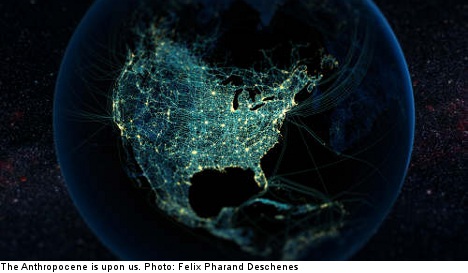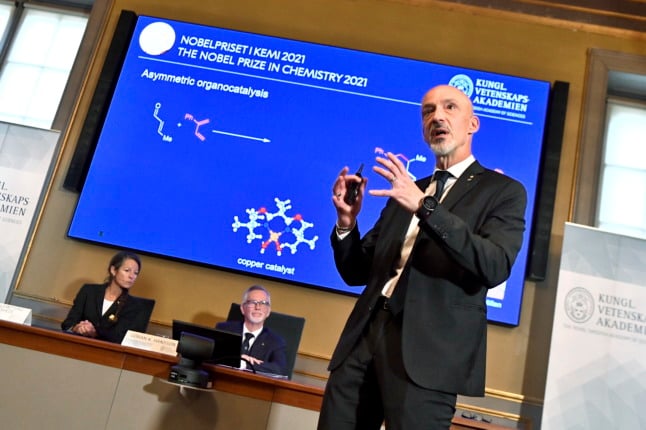Owen Gaffney is an Irishman based in Stockholm who works with a group of scientists on the Anthropocene – a concept developed by Nobel Laureate Paul Crutzen in 2000.
“The Anthropocene concept is that humans have pushed the earth into a new epoch,” Owen Gaffney, director of communications at Stockholm’s International Geosphere-Biosphere Programme (IGBP) tells The Local.
The programme is tasked with co-coordinating research into the multitude of processes (biological, chemical and physical) that occur in the world we live in, and how these interact with us humans.
Gaffney explains that since the end of the last ice age, the world was in a time period known as the Holocene, a period which oversaw the growth of the human species. The industrial revolution and massive growth of the fifties marked a turning point in modern civilization and today humans find themselves in a position where their actions impact their environment more than any other time.
“Now, we are changing the nitrogen cycle, the acidity of the oceans, earth’s land masses. We use an area the size of South America to grow our crops and an area the size of Africa for our livestock,” Gaffney observes.
“It’s a new concept, the idea that we have pushed the earth so far that we are in a new geological epoch.”
Together with Canadian anthropologist Felix Pharand Deschenes, Gaffney has created a video using data visualisation that illustrates the spread of globalisation and the extent of human impact on our Earth (below).
Welcome to the Anthropocene from WelcomeAnthropocene on Vimeo.
The video has been viewed over 800,000 times since it was published in April last year.
“We released it last year and it opened the UN’s Rio+20 summit on sustainable development, setting the scene for world and environmental leaders that this is where humanity is, this is the state of the planet,” Gaffney says.
The video was furthermore picked up by international media and even tweeted by Bill Gates.
Watch this video “Welcome to the Anthropocene” and read a book review from me on the same subject tomorrow: http://t.co/FVZlVStsIV
— Bill Gates (@BillGates) July 24, 2013
The video was also recently used by Sony Pictures in conjunction with Will Smith’s latest film After Earth to help educate why people need to be active in facing global change.
The video’s success underlies what the Anthropocene means culturally, Gaffney claims.
“The Anthropocene is a paradigm shift,” he says, likening it to the change in thought patterns when people realized the Earth revolves around the sun.
Such events forced society to re-evaluate their place in the universe, and have a cultural effect on people’s consciousness, he says.
“Simply, the Anthropocene shows that we have grown so large, so big, that we are the primary driver of change of Earth’s life support system,” he explains.
“This is very profound.”
Owen Gaffney notes that the idea that humans are causing huge change to the Earth’s biosphere is permeating beyond the scientific community and seeping into public consciousness. And it’s not just anthropologists and scientists that have been drawn to the concept.
“Artists have begun depicting images of the Anthropocene, thinking about what this means for societies,” he says. “I think this is why more and more artists, writers and musicians are being drawn to it, to explore it and try make sense of it.”
Gaffney’s own website – The Anthropocene Journal – is intended to help to bring these people together.
IN PICTURES: See artists impressions of the anthropocene
So what can we take from the Anthropocene, looking towards the issues that confront Earth in the future, particularly climate change and global warming?
“Firstly, the changes humans have made have benefited millions of people,” Gaffney notes.
“This must be the best time for anyone to be alive. But now humanity’s footprint is so huge we need to tread carefully so all nations can develop further. We are the first generation to really understand this responsibility.”
“Secondly, we have the technology to reduce greenhouse gas emissions and if we do manage to do that, we have a good chance of staying below the 2C target that policy makers have agreed to,” he adds.
However, the Irishman gave a stern warning that failing to take action is likely to result in devastating consequences.
“The warmer we get, the worse it will get,” he says.
New projects include an Anthropocene feature film in the form of a documentary in the works, as well as continuing to work with data visualization. But that’s not all for the science writer.
“I’m now creating a new data visualization to summarize the recent climate report that was finalized in Stockholm by the Intergovernmental Panel on Climate Change,” Gaffney tells The Local.
“It should be launched in a few weeks.”
Josh Liew



 Please whitelist us to continue reading.
Please whitelist us to continue reading.
Member comments